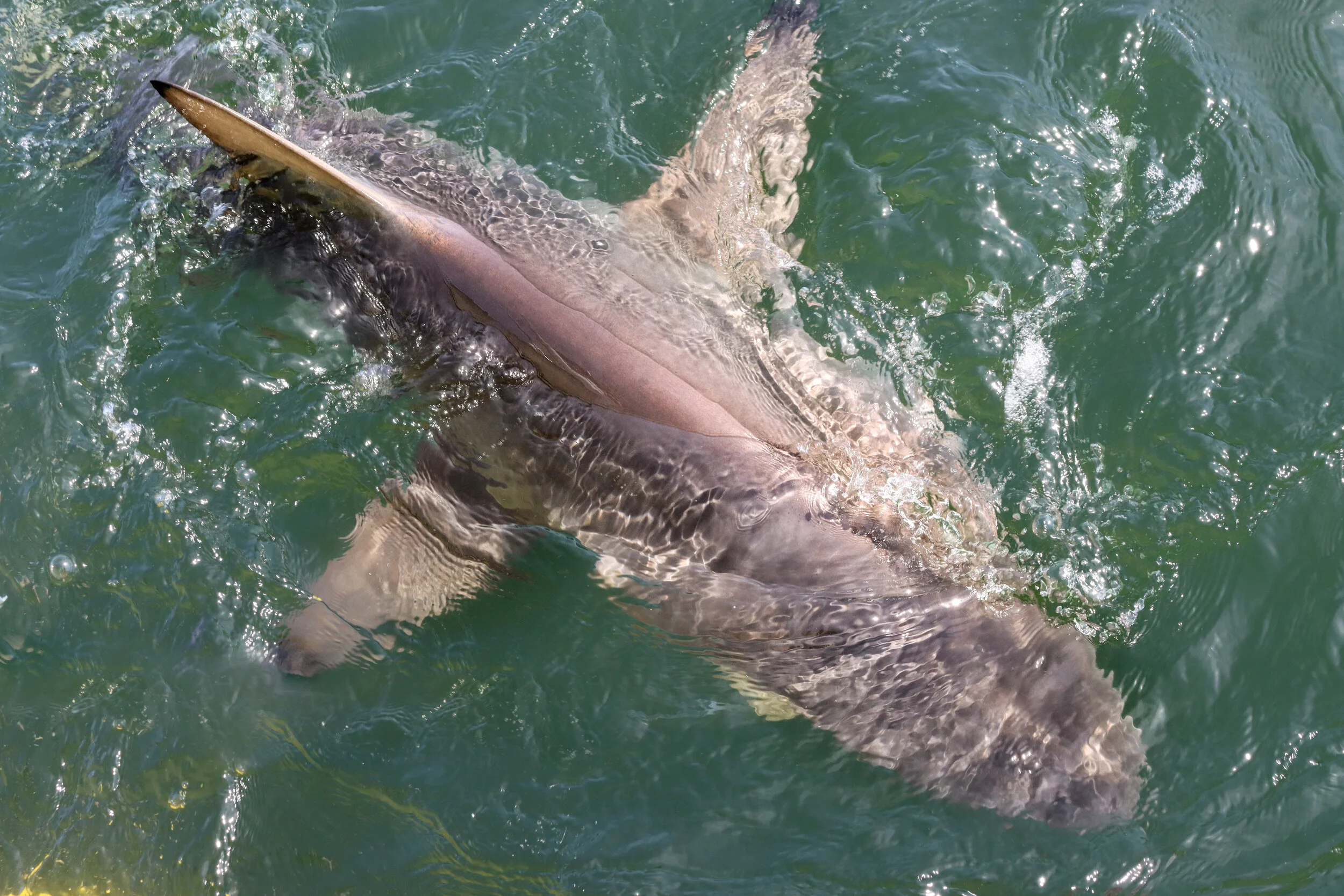#NTVArtists - Made in Menhaden: How an Unassuming Baitfish Fuels NY’s Marine Ecosystem (featuring footage + photos from Tim Regan (@SouthForkSalt))
Footage by Tim Regan
Written by Rich Nardo
They go by many names - Bunker, Menhaden, American Sardine, Pogy (not Porgy!), Mossbunker, Bug-head, Fat-back. No matter the nomenclature, it is indisputable that these pedestrian-looking baitfish are an important cog in the machine of the marine ecosystem around Long Island. They filter our water, they are an amazing source of omega-3 proteins with a myriad of human-based uses and, perhaps most importantly, menhaden are the primary food source for a lot of our ocean’s top predators. As Paul Greenberg pointed out in his 2009 NY Times Op-Ed, “Nearly every fish a fish eater likes to eat eats menhaden”.
For Long Island fisherman, the strength of a season often depends largely on the size of the bunker pods that are making their way through our waters. As the ASMFC prepares for a vote on a revolutionary new policy during the first week in August that will make menhaden the first species in the world to be managed on a multi-species model, let’s take an extensive look at these integral and undervalued members of the ocean’s food chain.
How They Feed
Bunker use their modified branchial apparatus (gill arches and gill rakers) to feed, filtering the water in the process. As they get older, their gill rakers grow larger and they begin to shift their diet from phytoplankton to zooplankton. This process has been found to help combat the deadly red algae tide that has decimated our coastal ecosystems for decades.
What They Feed
Bunker are the primary food source for everything from striped bass, tuna, red snapper, swordfish, weakfish and bluefish, to larger birds like ospreys and eagles and the marine mammals we enjoy in the northeast like humpback whales, dolphins, sea turtles and harbor seals. Thresher shark populations have grown thanks to a bunker resurgence as well. The result is a considerable thresher fishery at just 40-feet of water off Rockaway throughout June and July in recent years; something that we’ve never seen in that area before.
Where I live on the south shore of Long Island, I see osprey flying overhead with menhaden in talon almost every day, and out east it’s a remarkable site to see gannets dive-bomb bunker schools.
Adult bunker are incredibly efficient processors - filtering up to four gallons of water per minute. They are one of the few species of fish that are able to convert omega-3-rich sea plants to heart-healthy fatty acids. These fatty-acids are utilized by the game fish that eat them and, in turn, by us when we enjoy a fresh catch for dinner.
Human Uses and History
To this day, menhaden are the number one fish species harvested along the Atlantic coast by volume. Their value has been well known to people, dating back to Native Americans, who called them Munnawhatteug, which translates to “that which fertilizes”. It’s commonly said that bunker was the fish that Tisquantum (often called Squanto) used to teach the pilgrims how to fertilize their crops. Menhaden is also used for animal feed, bait for fishing, and in everyday products like lipstick, cookies, salad dressing, margarine and the aforementioned fish oil supplements.
While bunker are generally considered undesirable as food today, they were once a staple in the northeast. They were prepared as Europeans might do with sardines (hence the American Sardine name) and Maine fishermen would eat fried pogies for breakfast before a day at sea. The leftover bunker that wasn’t moved as bait would be sold to the poorer classes as food.
Concerns and Conservation
Because they have so many uses, menhaden have been tragically overfished. Over 400 million pounds are harvested every year. Current estimates say 30% of that catch is used for bait, while the remaining 70% is reduced into fishmeal for various uses. The primary culprit is the Canadian company, Omega Protein/Cooke Seafood, who are often found off New York’s coast throwing their seine nets that measure six city blocks. Ironically, Omega uses their catch to feed farmed salmon north of the border. In essence, they are harvesting a US resource needed for the health of local marine ecosystems in order to ship it to Canada and sell it back to Americans as farmed salmon. In doing so, they are dramatically harming our striped bass fishery - an important contributor to the U.S gross domestic product.
As John Gans from the Theodore Roosevelt Conservation Partnership puts it:
““Menhaden are vitally important forage for striped bass which is the most economically and culturally important sportfish in the Atlantic. A recent study, found that the 2016 striped bass fishery generated $7.8 billion toward our nation’s gross domestic product. “
”
As we’ve seen in past years, if the menhaden population suffers, striped bass aren’t the only population that feel the strain. Almost every large game fish in the area as well as those of our other beloved marine mammals also take a massive hit.
In 2017, a new management plan was put forward by the ASFMC (Atlantic States Fisheries Commission) to view bunker conservation, not just as an individual species, but also factoring in the needs of their predators when setting catch limits (called a multispecies conservation approach).
Due in large part to the efforts of the ASFMC, the New York State Senate and Assembly have both taken up the bunker cause, and proposed plans to eliminate bunker harvesting via purse seining. On April 18th, 2019, Governor Andrew Cuomo (who is an avid fisherman) signed two bills - A257 sponsored by Assemblyman Steven Englebright and S2317 sponsored by Senator Todd Kaminsky - into law. Both of which accomplish the goal of nixing purse seining from commercial bunker fishing.
If you’re a Long Islander who doesn’t think much about how a rebounding bunker populations improves your life, this article published on Nature.org captures the essence of what the resurging schools provides:
“It’s also providing New Yorkers with a glimpse of what Long Island’s coast might have been like back in the day. Think: coastal sharks crushing schools of menhaden in the surf, the deafening clatter of seabirds picking fish from above while predatory fish pursue menhaden from below, porpoises and dolphins frolicking where they haven’t been seen in decades. For many, the most spectacular sight is humpback whales lunging to feed on schools of menhaden right off Long Island beaches and New York City’s coast.
”
If you would like to help defend this vital species, you can donate and/or stay up-to-date with necessary actions through the Theodore Roosevelt Conservation Partnership or the Menhaden Defenders organization. Please visit their websites now for more information on the topic, including how you could help and where you can donate to the cause!
Theodore Roosevelt Conservation Partnership - https://www.trcp.org/menhaden-recovery/
Menhaden Defenders - www.menhadendefeners.org.
Thank you again to Tim Regan for the incredible footage and help on this blog. He’s one of my favorite accounts on Instagram, and I highly recommend you follow! His fishing reports for On The Water Magazine are also my go-to, and I highly recommend following along here.
South Fork Salt on Instagram: https://www.instagram.com/southforksalt/
South Fork Salt on YouTube: https://www.youtube.com/channel/UCGRaetvlKvBhJT6I6ToejfA/featured
Finally, thank you very much to John Gans from The Theodore Roosevelt Conservation Partnership for answering my questions and providing valuable feedback on the importance of Bunker conservation.
References for this Article:
https://en.wikipedia.org/wiki/Atlantic_menhaden
https://www.outdoorlife.com/articles/fishing/2016/06/10-things-you-probably-didnt-know-about-menhaden/
https://www.onthewater.com/the-bunker-handbook
https://conservefish.org/2017/06/19/why-bunker-matter/
https://www.edibleeastend.com/2010/08/17/the_food_chain/
https://www.cbf.org/about-the-bay/more-than-just-the-bay/chesapeake-wildlife/menhaden/?gclid=Cj0KCQjwu8r4BRCzARIsAA21i_AwqWPVo4PYDnU0xPWCQJmY_VuqwMRDJ48xJ7beP-Nejn5ccdt30HwaAh8BEALw_wcB
http://njsaltfish.com/index.php/bunker.html
https://www.nytimes.com/2018/09/13/nyregion/new-yorks-whales-love-bunker-so-do-fishing-boats-conflict-ensues.html
https://www.thefisherman.com/index.cfm?fuseaction=feature.display&feature_ID=2307&ParentCat=19
https://www.nature.org/en-us/about-us/where-we-work/united-states/new-york/stories-in-new-york/menhaden-whales-return-new-york/
https://shelterislandreporter.timesreview.com/2015/10/09/fish-on-de-bunking-the-bunker/
https://www.silive.com/entertainment/dining/2012/06/bunker_is_the_base_of_si_fishi.html
https://www.washingtonpost.com/opinions/local-opinions/its-time-to-take-politics-out-of-fisheries/2020/01/17/cff4a68c-364f-11ea-9541-9107303481a4_story.html
https://www.trcp.org/menhaden-recovery/










Ask any wildlife photographer or explore based on Long Island and they’ll tell you that our home turf does not get nearly the credit it deserves when it comes to species diversity. In fact, I think it’s safe to say that most people think Long Island has a couple of raccoons, a possum here and there, and way too many deer out east and that basically sums it up.
This couldn’t be further from the truth. So for this article, we worked with some of the best wildlife photographers based on Long Island to highlight 10 species that most people might not know we have here.